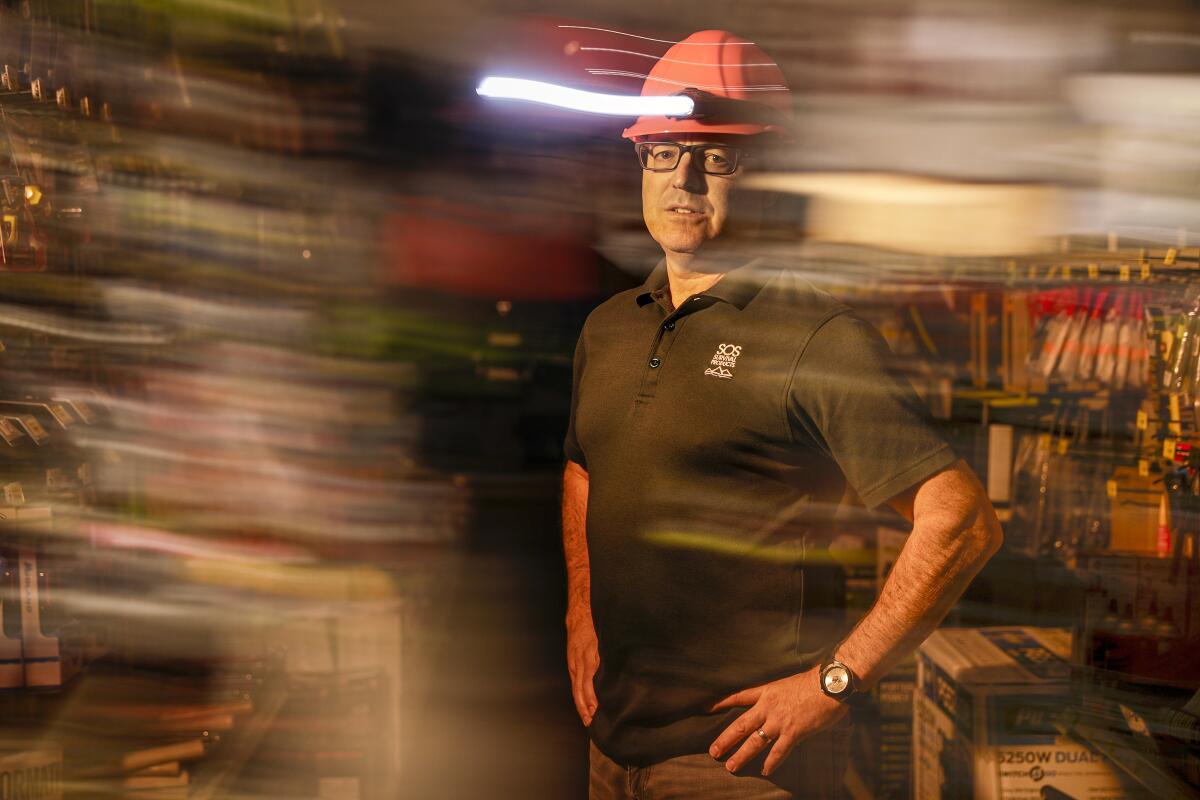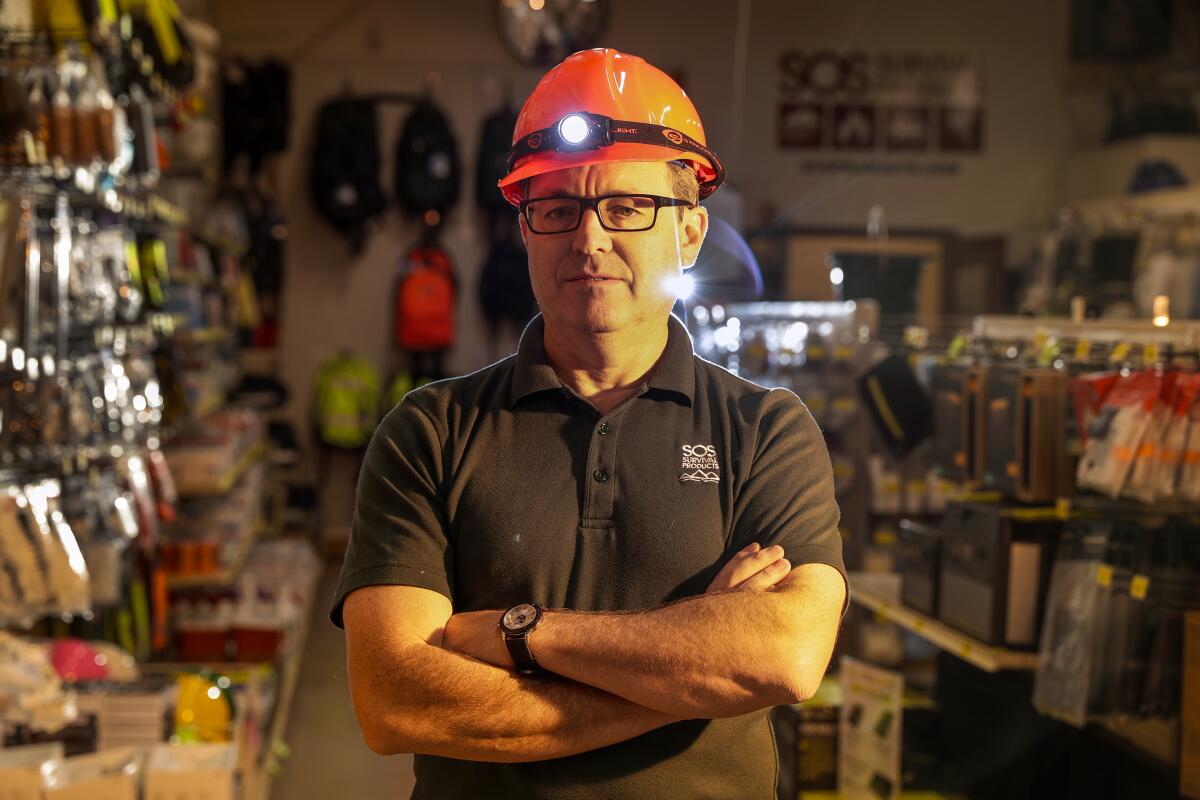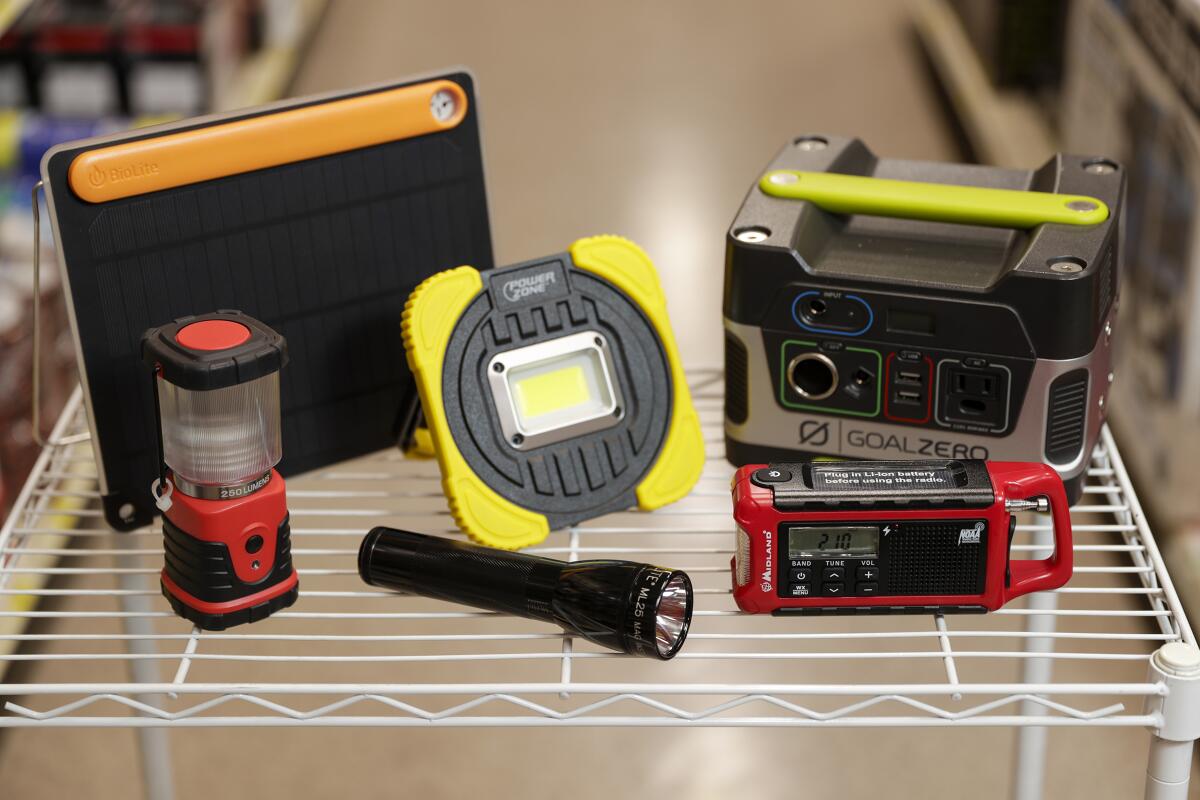Fear is big business: This store sells protection from fires, earthquakes, shooters and more

- Share via
Attorney Arezou Diarian thought she was ready for anything.
The 49-year-old mother of two had stocked her home’s bedroom closets with emergency kits, each capable of sustaining a family of four for three days should a fire, earthquake or other calamity strike. Diarian had first aid supplies and search-and-rescue equipment. There were particulate respirators and air filters to protect against air fouled by smoke and chemicals.
Then she visited SOS Survival Products, a low-slung, windowless cinder-block building utterly lacking in curb appeal. There, Diarian found out her preparations weren’t nearly good enough.
“I’m going to get an emergency kit for my office,” she said. “I bought a seat-belt cutter and car window breaker and pepper spray. I bought a crowbar, and I bought another first aid kit for my car.”
In a modest industrial section of Van Nuys, SOS owner Jeff Edelstein caters to the fear of the day.
Wildfires? He’s got eight kinds of filtration masks and multiple types of preassembled backpack kits to grab and go.
Earthquake? He’ll show customers how to store enough water for a week or more and to secure furniture and cabinets.
Power outage? He’s got a solar-powered generator that can run a CPAP breathing machine overnight. There are bigger generators too, with training in proper operation to avoid carbon-monoxide poisoning.
In need of temporary shelter? He has tents, cots, bedding, portable toilets and pop-up privacy shelters.

Edelstein, 51, has been in the emergency preparedness business since 1989, the year of the deadly Loma Prieta earthquake in Northern California, immortalized by a seismic image on the store’s wall. Edelstein started out selling supplies in his father’s Westchester hardware store and later opened his own place peddling protection and peace of mind.
To inject a little lightheartedness into an otherwise grim enterprise, Edelstein displays Zombie Survival Kits containing “the necessary items to sustain one person for two days of survival during an apocalypse or any type of disaster.” After all, surviving any emergency requires food, water, shelter, sanitation facilities and the ability to render first aid.
Diarian wasn’t fazed by the zombie references, but some items stopped her cold, such as the classroom lockdown kits for active shooter emergencies.
Each kit, in a black five-gallon bucket, includes a portable toilet, wipes, vinyl gloves, duct tape, cat litter for absorbing messes and a tarp for privacy. “In the end, it’s an item no school should be without,” said the ad for the product.
“That was disheartening,” Diarian said. “But it also made me feel good to know that people are realizing that this is the reality we now live in, and we just need to be prepared.”

Disaster worries among individuals, schools, businesses and government agencies are driving a surge in spending to prepare for and react to global emergencies. The worldwide market for such products and services was $75.5 billion in 2017 and is predicted to increase to $423 billion by 2025, according to research firm Allied Market Research.
The report cited a rise in the need for “safety and security solutions, owing to increases in natural calamities and terrorist attacks, implementation of regulatory policies for public safety and the necessity of emergency preparedness.”
From 1980 through 2018, the U.S. endured an annual average of 6.3 weather or climate-related disasters that caused at least $1 billion in damages, adjusted for inflation, according to the Commerce Department’s National Oceanic and Atmospheric Administration. So far in 2019, there have been 10 such events, NOAA said.
In California, wildfires torched more than 1.2 million acres in 2017 and 1.6 million acres in 2018, according to the California Department of Forestry and Fire Protection and the U.S. Forest Service.
This year’s preventive power outages to avoid fires started by utility equipment have affected millions of customers.
The number of active shooter incidents rose to 30 in 2017 and 27 in 2018 from 21 or fewer in each of the previous six years, the FBI reports.

Increases in the frequency and severity of man-made and natural disasters has created a kind of collective global unease, experts say.
“We are learning to think about the unthinkable. This is the opposite of complacency, and that should be the motto for this day and age,” said Naj Meshkati, a USC professor of civil and environmental engineering, industrial systems engineering and international relations. Meshkati has traveled extensively to study disaster sites such as Japan’s Fukushima Daiichi power plant, which was severely damaged in 2011 by a magnitude 9 earthquake and subsequent tsunami.
“Both the natural and man-made disasters of the recent past have exceeded our expectations,” Meshkati said. “It is not safe to settle for what you have done.”
SOS Survival Products isn’t alone in its mission. Most hardware retailers, military surplus stores and camping equipment sellers carry some of what Edelstein does.
Such merchants tend to get a boost right after an earthquake or wildfire or on the anniversary of a disaster. At times like that, Edelstein will add a few employees to his regular roster of 14.

But SOS also draws a regular clientele that wants to be well supplied for the end of the world as we know it. Some longtime customers, who were reluctant to be interviewed or give their full names, said they could survive on their own for a month or longer after a disaster, and they’re not inclined to share.
“I don’t want anyone else knowing how many supplies we have,” said a U.S. Navy veteran who would identify himself only as Joe. “I’m not doing this to save everyone in the neighborhood.”
Among SOS’ customers is the 10,000-student Redondo Beach Unified School District. Preparing for the possibility of emergencies, such as an intruder with a gun, has been one of the most challenging tasks that schools Supt. Stephen E. Keller said he has faced.
“I have struggled a bit as a leader because this was not my forte,” Keller said. “But we are diligent, relentless and open-minded about the threats that could be out there.”
Edelstein’s father and grandfather both ran traditional hardware stores, making his survival products store a kind of third-generation affair.
“I grew up around hardware stores. I loved the smell of them,” Edelstein said. As early as 11 years old, he said, “I could tell you about any of the products in my dad’s store.”

For many years, Edelstein said, SOS Survival Products “was all about natural disasters, earthquake kits or emergency kits. We always sold supplies to schools, like a classroom kit for teachers. So, if there was a disaster, they had items that they could use to keep their kids safe.”
Most people don’t spend enough time preparing for an emergency, and once an event such as a quake recedes in memory, the concerns are forgotten, Edelstein said.
“First panic sets in, and then they want to buy everything and anything that’s available. That’s exactly what happened after we had the 7.1 earthquake on July 5th in the Ridgecrest area of California,” Edelstein said.
“We had people coming into the store bringing old emergency kits that they purchased after the Northridge earthquake in 1994,” Edelstein said. “Items that had a five-year shelf life that expired more than 20 years ago.”
Edelstein’s business conducts classes, most of which are free, on topics such as basic emergency preparedness or surviving active shooter incidents. Classes listed on the company website include how to operate two-way radios and emergency power options during electrical grid shutdowns.
“We’ve been able to train thousands of people through the store to be better prepared before the next disaster,” Edelstein said. “It’s not a sales pitch. It’s informative, using past disasters and examples of different things that have happened to give people ideas of how to prepare themselves for an earthquake, or fire or whatever the case may be.”
Under severe fluorescent lighting, Diarian wandered through the no-frills 1,500-square-foot store, which resembles a 1950s hardware store for survivalists. Attached is a more than 12,000-square-foot warehouse with even more survival products.
Edelstein advised her to place a bag under each bed in the household with “just your absolute essentials”: a flashlight, shoes, an extra set of clothes, light sticks, a whistle to signal for help, a pair of gloves and a crowbar to pry open windows or doors that are stuck after an earthquake.
Edelstein said he tells customers to have at least a week’s worth of supplies and to stock more canned goods than freeze-dried food because so-called MREs, or meals ready to eat, require water, which cuts into what might already be an inadequate amount for drinking.
“I definitely need more food, and I need more water,” Diarian said, “and when the cans get older, I’m going to swap them out and replenish them with new cans and just try to stay on top of it.”
Fear is a powerful motivator.
“Never would I have anticipated a lot of the things happening in our country,” Edelstein said. “When I first started, I thought, ‘Oh, we’ll make some different kits and we’ll sell them to different hardware stores.’ And then, we started working with school districts, cities. Over 5,000 different items later, we’re still adding and expanding.”
More to Read
Inside the business of entertainment
The Wide Shot brings you news, analysis and insights on everything from streaming wars to production — and what it all means for the future.
You may occasionally receive promotional content from the Los Angeles Times.











